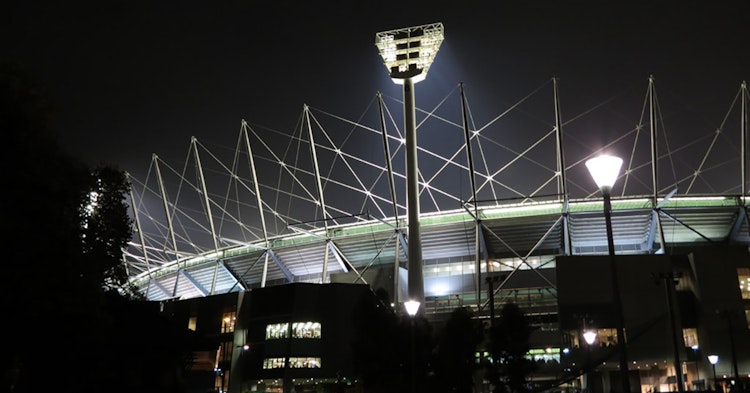Around the Grounds in the Big Bash League
Last updated: Dec 17, 2019, 12:52AM | Published: Dec 16, 2019, 11:41AM
This image is a derivative of Melbourne Cricket Stadium by FlorisHJ (CC BY-SA 2.0)
Cricket season has arrived, and with it the annual road trip we get to take around Australia’s most iconic cricket venues. Soon the BBL will be back on our TV screens every night and summer will be in full swing.
To help us warm up for this year’s tournament, we thought we’d take a deeper dive into the scoring patterns at each of the major BBL venues, keeping an eye on any interesting trends in the data and patterns that may emerge.
BBL STATS: Identifying the DNA of a BBL Innings
JOIN THE MAILING LIST: Create a free account and get the best content delivered straight to your inbox
* These statistics specifically exclude matches where there was no result, or where the Duckworth-Lewis method was applied.
The General
Let’s start by looking at the average first innings score at each of the major venues since the Big Bash League’s inception in 2011. As you can see in the graph below, the Gabba has historically been a happy hunting ground for batsmen, topping the charts with an average first innings score of 170.8 - 11.4 runs above the competition average of 159.4, no doubt - at least in part - spurred on by being the long-term home of Chris Lynn and (the now retired) Brendan McCullum, plying their trade with the Brisbane Heat.
If we exclude the Heat, opposing teams have also enjoyed spending time in the middle at ‘the Gabba,’ with an average ‘away team’ first innings score of 168.6 still enough to see it sit atop this list, without the ‘Bash Brothers’ spectacular influence.

The shorter square boundaries at Blundstone Arena (Hobart) and the Adelaide Oval round out the remaining podium spots, with bigger grounds like the MCG and SCG further down the list.
RELATED: Breaking Down Home Ground Advantage In The BBL
As a side note, six out of the eight batsmen to take home the leading run scorer award for a BBL season have played for teams based at one of the Gabba, Blundstone Arena or the Adelaide Oval. Whilst the average scores at these venues may in part be driven by the presence of such batsmen, it seems batters do get at least some form of a boost in the leading run-scorer race by calling one of these particular grounds ‘home.’
Given Optus Stadium is now the home of the Perth Scorchers we have included it here for comparison, however, the numbers must be taken with a grain of salt as far fewer games have been played there compared to the other venues. The overall average is also somewhat inflated by the 210 that was scored at Optus Stadium in the Semi Final of BBL07.
Removing that particular score drags the average first innings score back to 156.7.
The Winners
We’ve had a look at the average first innings score, but how does that translate into a result? The graph below shows the average winning first innings score at each of the venues we’ve touched on, and straight away you’ll notice one thing – they are higher.
In fact, they range from 3%-13% higher than each venue’s respective average, with the averaging winning score across all grounds landing approximately 8% higher than the competition average of 159.4 runs per first inning we previously mentioned.

Now, you may be wondering; “why such a jump?”
There are a couple of things that spring to mind:
One comes from what the data is telling us about the BBL so far, that is; on average, it hasn’t been an equal contest between teams batting first and teams batting second.
Overall, chasing teams have won 53.9% of the time - and that number has even increased to 59% over the last 4 BBL seasons, which is a little bit different to the old cricketing adage that '9/10 times you should bat first, and the 10th time, you think about bowling - and bat.'
However, T20 cricket is a dynamic game, and as such, captains have been forced to adapt.
What that means, as a very broad statement, is that teams batting first - in general - need to score above the average first innings score to turn a game into an equal, 50-50 contest at the change of innings.
READ: How Important Is Winning The Toss In a Big Bash Match?
Obviously there are many other factors such as strength of opposition batsmen and your own bowling attack which are relevant here, but again, we are just using this as a general statement for illustrative purposes.
Another more procedural factor is to do with the inherent nature of averages – specifically, they can be influenced by ‘outliers’ (e.g massive scores) in the dataset, particularly when we are dealing with smaller sample sizes. The previous point about Optus Stadium is an example of that. If a team gets a massive score it makes sense they are more likely to win a game, hence these ‘massive scores’ make up a higher proportion of ‘winning’ first innings scores when compared to overall ‘first innings’ scores in the general sense - which can have the effect of bumping up this number.
For reference, we also looked at median winning first innings scores, and the numbers were not massively different, so for the purpose of this piece we’ve stuck with averages.
The Trends
The graph below shows how the average first innings score has changed in each edition of the BBL. Since BBL02 we can see this line, in general, has followed an upward trajectory.

As T20 cricket has moved away from the ‘hit and giggle’ status it had in its early years, it appears teams (and the batsmen themselves) have refined their approach to batting in the first innings. This, coupled with improved bat technology, and what seemed to be ever-improving batting wickets, offers a possible explanation for the general upward trend depicted in the data.
What really sticks out, however, is the sudden drop between BBL07 and BBL08, with the average score of 154.9 representing the second lowest number since the competition’s inception, which really flies in the face of what we have mentioned above.
The graph below offers a comparison between the average first innings score at each venue in last year’s BBL, and their overall number. Only two venues - Adelaide Oval and the MCG - saw an uptick in BBL08, with the traditional batting haven of the Gabba being one of the worst hit. Keep in mind, the Gabba hosted the equal lowest number of matches for a stadium to make this list in BBL08, and the Heat did manage to chase down 156 in the space of 10 overs there at one point!
Marvel Stadium, too, also experienced a significant dip, as batsmen seemed to struggle on a wicket that was, at times, a bit sticky and slow to score on.

There has been a lot of chat around the evenness of the contest between bat and ball in T20 cricket, with the general consensus being the battle has shifted in favour of the batsman in recent years. Perhaps a possible explanation for this drop-off, is a decision to re-introduce a bit more life into pitches in an attempt to square the ledger during BBL08. Or perhaps even the law changes in 2017 regulating the size of bats have started to nibble into teams scores.
The last couple of seasons have also seen a push by Cricket Australia to take more games to regional venues. Last year, approximately 16% of all games were played away from the home team’s ‘major home ground,’ with that number just 4.7% over the competition’s entire history.
RELATED: Breaking Down Home Ground Advantage In The BBL
I’m a big fan of giving more people the opportunity to get to a BBL game than otherwise might if matches were purely based in the city (and by no means am I trying to suggest there should be less of it), but, and with no disrespect to the facilities/curators at these more ‘regional’ grounds - based on the level of resources available to them - it’s possible that the wickets aren’t quite as good as at our international venues. This, coupled with the increased number of games played at these grounds, may also have contributed to a dip in scores in BBL08.
On that note, however, the average score at these venues in BBL08 was 157.33 – so whilst it may have played a part, it does seem there were still other forces at play.
It’s also quite possible that bowlers have changed their game to adapt to more aggressive batsmen, or the batsmen simply had an off year, or even that it was just a random blip on the radar and the line will revert back to its normal path this season.
We are not attempting to offer a concrete answer here, but just throwing a few ideas around as to what may have been some of the contributing factors.
In any event, it will be interesting to watch this space as the season progresses.
Did you enjoy this article? Subscribe to our free mailing list to get the best content delivered straight to your inbox.
Leave a comment below, or join the conversation on the Stats Insider Twitter or Facebook page.



